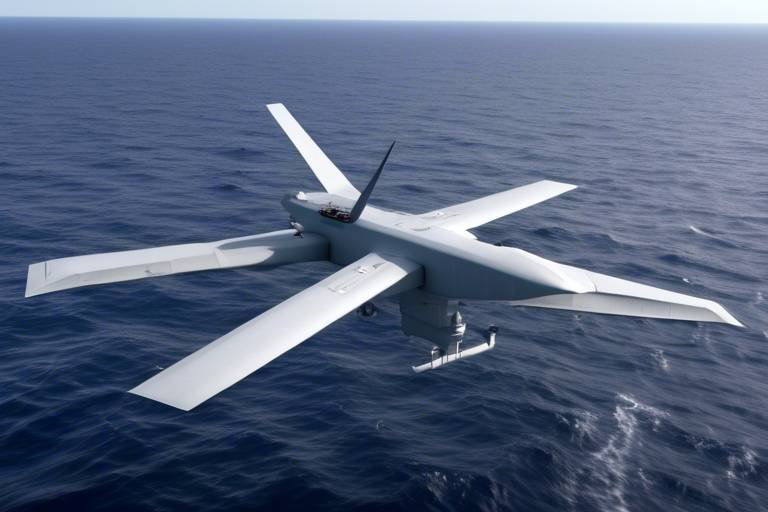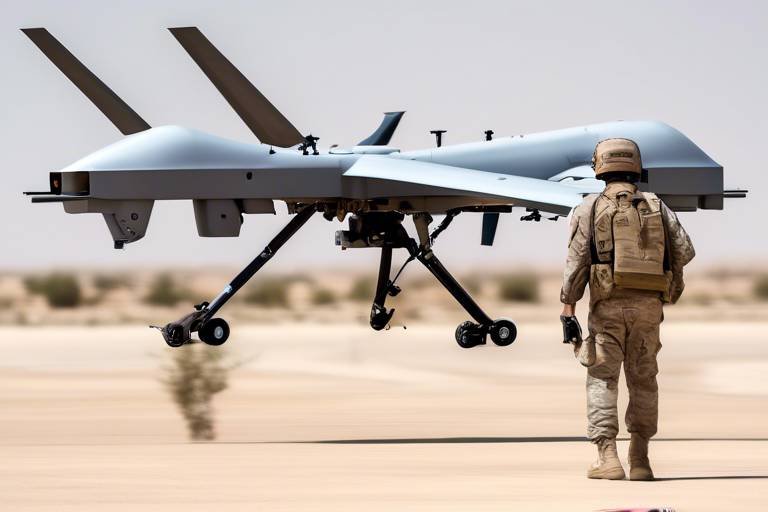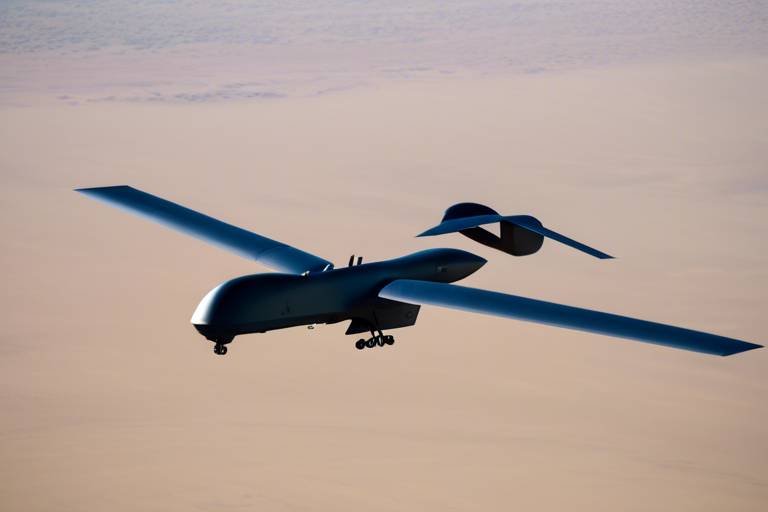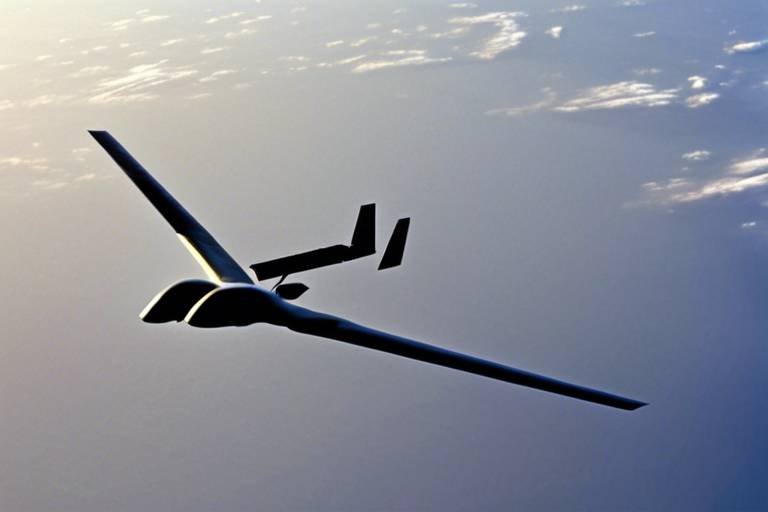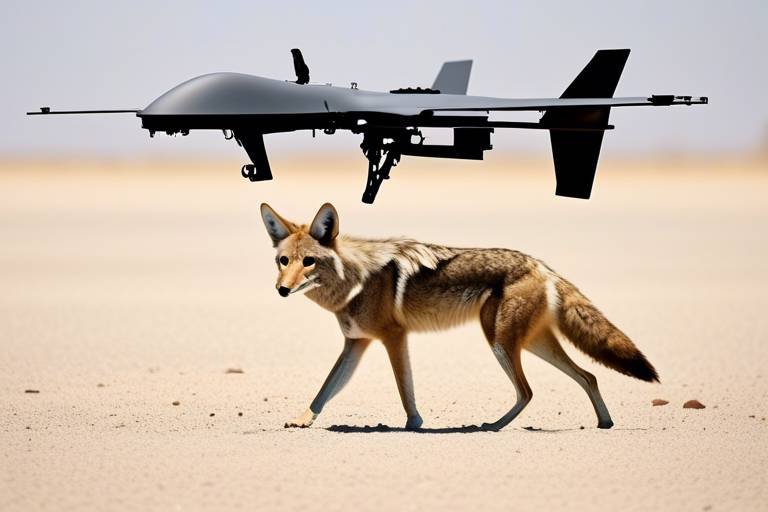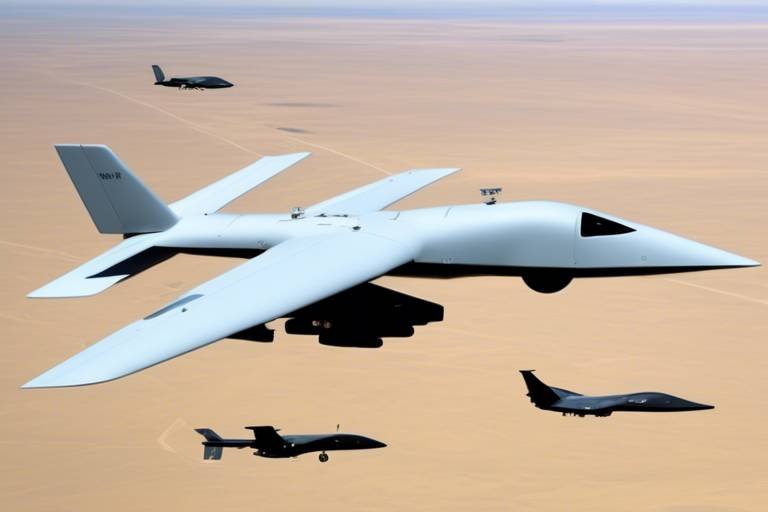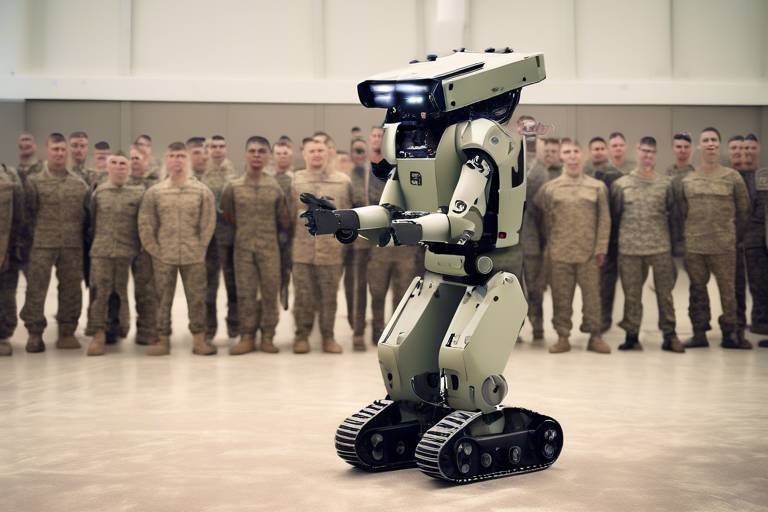Assessing the Applications of the RQ-21A in Military Operations
The RQ-21A, an unmanned aerial vehicle (UAV), is a game changer in the realm of military operations. With its multifaceted capabilities, it not only redefines the way military forces conduct operations but also enhances their effectiveness on the battlefield. Imagine having a bird's-eye view of the terrain, enemy positions, and potential threats, all while keeping troops safe and informed. That’s precisely what the RQ-21A brings to the table. This article dives deep into its roles and capabilities, shedding light on how this remarkable UAV is reshaping military strategies and operations.
The RQ-21A is not just another drone; it’s a versatile UAV designed for both land and maritime operations. Built with cutting-edge technology, it features a robust airframe that can withstand various environmental conditions. Weighing in at around 50 pounds and with a wingspan of approximately 14 feet, it’s compact yet powerful. The UAV boasts an impressive endurance of up to 24 hours, allowing it to cover vast areas without needing frequent recharges. Equipped with advanced sensors and communication systems, the RQ-21A can gather and relay critical information in real time, making it an invaluable asset for military operations.
The RQ-21A serves multiple operational roles, primarily focusing on intelligence, surveillance, and reconnaissance (ISR). In today's fast-paced military environment, the ability to gather information swiftly and accurately can mean the difference between success and failure. The UAV excels in various military scenarios, providing commanders with the situational awareness needed to make informed decisions. Whether it’s monitoring enemy movements or assessing battlefield conditions, the RQ-21A is always on the front lines, delivering crucial data that keeps troops one step ahead.
Intelligence gathering is a critical function of the RQ-21A. This UAV is equipped with sophisticated imaging and sensor technologies that enable it to collect valuable data from the battlefield. Imagine a scenario where ground forces are advancing into potentially hostile territory. The RQ-21A can be deployed to scout ahead, gathering information on enemy positions and movements. This data is then transmitted back to command centers, allowing military leaders to strategize effectively. The UAV’s ability to operate in real-time means that commanders can adapt their tactics on the fly, ensuring that they remain agile and responsive.
Real-time data transmission capabilities are a cornerstone of the RQ-21A's effectiveness. With advanced communication systems, the UAV can relay information almost instantaneously. This capability is vital for maintaining situational awareness on the battlefield. The technology behind its communication systems ensures that data is not only transmitted quickly but also securely, minimizing the risk of interception by enemy forces. This level of operational efficiency allows military units to stay informed and prepared, ultimately enhancing mission success rates.
Once data is collected, the RQ-21A employs sophisticated data analysis and processing methods to enhance mission effectiveness. The UAV is equipped with onboard processing capabilities that allow it to filter and prioritize the data it collects. This means that only the most pertinent information is relayed back to command, saving time and resources. Additionally, the integration of artificial intelligence in data processing enables the RQ-21A to identify patterns and anomalies, providing actionable insights that can be critical during military operations.
Equipped with advanced surveillance technologies, the RQ-21A is a powerful tool for monitoring designated areas. Its array of sensors, including electro-optical and infrared cameras, allows it to conduct comprehensive surveillance during both day and night. This capability is particularly important for identifying potential threats and assessing battlefield conditions. The UAV can cover large swathes of land or sea, providing commanders with a detailed understanding of the operational environment. By integrating these surveillance capabilities with real-time data transmission, the RQ-21A ensures that military forces have the information they need to make timely decisions.
The RQ-21A doesn't operate in isolation; it works alongside various military assets, enhancing overall operational effectiveness. Its interoperability with other platforms and units is crucial in joint missions. For example, when deployed with ground troops, the UAV can provide reconnaissance and targeting information that significantly improves the safety and effectiveness of operations. This collaborative approach ensures that all military assets are working towards a common goal, maximizing their collective impact on the battlefield.
One of the most significant advantages of the RQ-21A is its ability to provide critical support for ground troops. By offering reconnaissance and targeting information, the UAV enhances troop safety and operational success. Imagine a squad of soldiers advancing through a dense forest; the RQ-21A can scout the area ahead, identifying enemy positions and potential ambushes. This not only helps in planning tactical maneuvers but also boosts the confidence of ground troops, knowing they have aerial support watching over them.
The UAV's capabilities extend to naval operations as well, where it supports maritime surveillance. In a world where naval engagements can be unpredictable, the RQ-21A provides essential situational awareness for naval forces during missions. By monitoring vast ocean areas, it can detect threats, track movements, and relay information back to naval commanders. This collaboration between aerial and naval forces enhances operational effectiveness, ensuring that military units are well-prepared for any challenges they may face.
- What is the range of the RQ-21A? The RQ-21A has a range of approximately 50 nautical miles from its launch point.
- How long can the RQ-21A stay in the air? The UAV can operate for up to 24 hours, depending on the mission profile and payload.
- What types of sensors does the RQ-21A carry? It is equipped with electro-optical, infrared, and other advanced sensors for surveillance and reconnaissance.
- Can the RQ-21A operate in adverse weather conditions? Yes, the RQ-21A is designed to perform in various environmental conditions, making it a reliable asset in diverse scenarios.

Overview of the RQ-21A
The RQ-21A is not just another unmanned aerial vehicle (UAV); it represents a leap forward in military technology, designed to operate effectively in both land and maritime environments. With its compact design and advanced capabilities, this UAV is tailored to meet the diverse needs of modern military operations. Let's dive into what makes the RQ-21A a vital asset on the battlefield.
First off, the RQ-21A boasts a wingspan of approximately 14 feet and can carry a payload of around 50 pounds. This includes a variety of sensors and communication systems that enhance its operational versatility. One of its standout features is its ability to take off and land from small ships and land bases, making it incredibly adaptable to different mission requirements. The UAV is equipped with a high-definition camera and infrared sensors, which allow for both day and night operations, ensuring that it can gather critical intelligence regardless of the time or weather conditions.
Another remarkable aspect of the RQ-21A is its flight endurance. It can stay airborne for up to 12 hours, allowing for extended surveillance missions without the need for frequent refueling. This endurance is complemented by its advanced autopilot system, which enables it to navigate complex environments autonomously or under remote control. The UAV's operational range extends up to 100 nautical miles from its launch point, providing military commanders with a significant tactical advantage.
In terms of technology, the RQ-21A is equipped with secure communications systems that facilitate real-time data sharing. This feature is crucial for modern military operations, where timely and accurate information can make the difference between success and failure. The UAV's onboard systems are designed to process and transmit data quickly, ensuring that decision-makers have access to the information they need when they need it.
To summarize, the RQ-21A is a highly capable UAV that combines advanced technology with operational flexibility. Its ability to perform in diverse environments, coupled with its robust data-gathering capabilities, positions it as a key player in military operations. Below is a table summarizing the key specifications of the RQ-21A:
| Specification | Details |
|---|---|
| Wingspan | 14 feet |
| Payload Capacity | 50 pounds |
| Flight Endurance | Up to 12 hours |
| Operational Range | 100 nautical miles |
| Key Features | Day/Night Operations, Real-time Data Transmission, Autopilot Navigation |
In conclusion, the RQ-21A is not merely a technological marvel; it is a vital instrument that enhances the effectiveness of military operations. Its ability to adapt to various operational demands makes it an indispensable part of modern warfare strategy.
- What is the primary purpose of the RQ-21A? The RQ-21A is primarily used for intelligence, surveillance, and reconnaissance (ISR) missions.
- How long can the RQ-21A fly without refueling? The RQ-21A can stay airborne for up to 12 hours.
- Can the RQ-21A operate in adverse weather conditions? Yes, it is equipped with advanced sensors that allow for operations in various weather conditions.
- Is the RQ-21A capable of real-time data transmission? Absolutely, it features secure communication systems for real-time data sharing.

Operational Roles of the RQ-21A
The RQ-21A unmanned aerial vehicle (UAV) is a game-changer in modern military operations, serving multiple critical roles that enhance mission success. Its versatility allows it to adapt to various operational environments, making it an invaluable asset on the battlefield. One of the primary functions of the RQ-21A is its ability to conduct intelligence, surveillance, and reconnaissance (ISR) missions, which are essential for gathering actionable data and maintaining situational awareness. Imagine having an eye in the sky that can pinpoint enemy positions, monitor troop movements, and provide real-time feedback to commanders on the ground. This capability not only streamlines decision-making processes but also significantly reduces risks to human personnel.
In the realm of ISR, the RQ-21A excels at collecting data through its sophisticated sensors and cameras. These devices allow the UAV to capture high-resolution imagery and video, which can then be analyzed to provide insights into enemy activities and potential threats. The UAV's ability to operate at various altitudes and its extended flight duration make it ideal for persistent surveillance over a designated area. This is particularly important in situations where ground forces need to understand the battlefield dynamics without exposing themselves to enemy fire.
Moreover, the RQ-21A plays a vital role in real-time intelligence gathering. With its advanced communication systems, the UAV can transmit data back to command centers almost instantaneously. This feature ensures that military leaders have access to the most current information, allowing them to make informed decisions quickly. For instance, during a reconnaissance mission, the RQ-21A can relay images and data while still in flight, enabling commanders to adjust their strategies on the fly. This level of responsiveness can be the difference between success and failure in military operations.
To further illustrate the operational roles of the RQ-21A, consider the following table that outlines its key capabilities:
| Operational Role | Description |
|---|---|
| Intelligence Gathering | Collects and transmits vital data for decision-making. |
| Surveillance | Monitors enemy movements and activities in real-time. |
| Reconnaissance | Provides detailed imagery and information on terrain and targets. |
| Targeting Support | Assists in identifying and engaging enemy positions. |
Additionally, the RQ-21A's surveillance capabilities are enhanced by its array of sensors, which can include electro-optical and infrared systems. These technologies allow the UAV to operate effectively in various weather conditions and times of day, ensuring that military operations can continue without interruption. The combination of these features not only boosts the operational efficiency of military missions but also enhances the safety of personnel by reducing their exposure to danger.
In summary, the operational roles of the RQ-21A are multifaceted and integral to modern military strategies. Its capacity for ISR, real-time data transmission, and advanced surveillance makes it a critical asset that supports ground and naval forces alike. As military operations continue to evolve, the RQ-21A stands out as a symbol of how technology can transform the battlefield, providing a tactical advantage that is hard to match.
- What is the RQ-21A used for? The RQ-21A is primarily used for intelligence, surveillance, and reconnaissance (ISR) missions, providing real-time data to military commanders.
- How does the RQ-21A enhance military operations? By offering persistent surveillance and immediate data transmission, the RQ-21A helps military leaders make informed decisions quickly, improving overall mission effectiveness.
- What technologies does the RQ-21A utilize? The RQ-21A is equipped with advanced sensors, including electro-optical and infrared systems, allowing it to operate in various conditions and times.
- Can the RQ-21A support ground troops? Yes, the RQ-21A provides critical reconnaissance and targeting information that enhances the safety and effectiveness of ground operations.

Intelligence Gathering
The RQ-21A unmanned aerial vehicle (UAV) plays a pivotal role in the realm of military intelligence gathering. Imagine a bird’s-eye view of a battlefield, where every movement and detail is captured in real-time. This is precisely what the RQ-21A offers. With its sophisticated sensors and advanced technology, it collects crucial data that informs military decision-making processes. The UAV is not just a flying camera; it’s a comprehensive intelligence platform that can transform raw data into actionable insights.
One of the standout features of the RQ-21A is its ability to operate in diverse environments, whether in rugged terrains or over expansive waters. This versatility allows military commanders to gain insights into enemy positions, troop movements, and even potential threats that are otherwise difficult to detect. The UAV's multi-spectral sensors can capture images and data across various wavelengths, providing a detailed picture of the operational landscape. This capability is essential for identifying targets, assessing damage, and planning subsequent operations.
Furthermore, the RQ-21A excels in real-time data transmission. Imagine being able to see a live feed of an area of interest while troops are on the ground, making decisions based on current conditions rather than outdated information. This real-time capability is made possible through its advanced communication systems, which ensure that data is sent back to command centers without delay. As a result, military personnel can react swiftly to changing situations, enhancing their overall operational effectiveness.
In addition to its data collection capabilities, the RQ-21A also incorporates sophisticated data analysis and processing tools. Once the information is gathered, it undergoes rigorous analysis to extract meaningful insights. This process involves utilizing algorithms and software that can sift through vast amounts of data to identify patterns and anomalies. For instance, if the UAV detects unusual activity in a specific area, this information can be flagged for further investigation, allowing military planners to allocate resources efficiently and effectively.
To illustrate the importance of this intelligence gathering, consider the following table that outlines the key capabilities of the RQ-21A in this domain:
| Capability | Description |
|---|---|
| Multi-Spectral Imaging | Captures data across various wavelengths for comprehensive situational awareness. |
| Real-Time Transmission | Provides live feeds and immediate data to command centers for swift decision-making. |
| Data Processing Tools | Utilizes advanced algorithms to analyze and interpret collected data for actionable insights. |
In conclusion, the intelligence gathering capabilities of the RQ-21A UAV are not just about collecting data; they are about transforming that data into a strategic advantage on the battlefield. By providing real-time insights and in-depth analysis, the RQ-21A empowers military forces to make informed decisions, enhancing their operational efficiency and effectiveness. As military operations continue to evolve, the role of UAVs like the RQ-21A in intelligence gathering will only grow, making them indispensable assets in modern warfare.
- What is the primary function of the RQ-21A? The RQ-21A primarily functions as an unmanned aerial vehicle for intelligence, surveillance, and reconnaissance (ISR) missions.
- How does the RQ-21A transmit data? The RQ-21A uses advanced communication systems to transmit data in real-time back to command centers.
- What types of sensors does the RQ-21A use? The RQ-21A is equipped with multi-spectral sensors that capture data across various wavelengths for detailed analysis.
- Can the RQ-21A operate in adverse weather conditions? Yes, the RQ-21A is designed to operate in a variety of environmental conditions, making it versatile for different military operations.

Real-time Data Transmission
The RQ-21A unmanned aerial vehicle (UAV) is a game-changer in military operations, particularly when it comes to . Imagine being in a high-stakes game of chess, where every move counts and the outcome can change in an instant. The RQ-21A acts as your eyes in the sky, providing immediate insights that can turn the tide of any mission. This UAV is equipped with advanced communication systems that allow it to send and receive data almost instantaneously, ensuring that military personnel are always a step ahead.
One of the standout features of the RQ-21A is its ability to transmit high-definition video and sensor data in real-time. This capability is crucial for maintaining situational awareness on the battlefield. For instance, when ground troops are moving into potentially hostile territory, having access to live feeds from the UAV allows commanders to make informed decisions based on current conditions. This not only enhances operational effectiveness but also significantly increases troop safety.
To better understand how this technology works, let’s break it down into key components:
- Data Link Systems: The RQ-21A utilizes advanced data link systems that provide a secure and reliable connection between the UAV and ground control stations. This ensures that the information transmitted is not only fast but also protected from interception.
- Sensor Integration: The UAV is equipped with a variety of sensors, including electro-optical and infrared cameras, which feed real-time data back to operators. This integration allows for comprehensive monitoring of the operational environment.
- Mobile Command Centers: Ground forces can deploy mobile command centers that receive data from the RQ-21A, enabling them to act quickly based on the information provided.
Moreover, the RQ-21A’s real-time data transmission capability is not just about speed; it’s also about accuracy. The UAV can filter and prioritize data, ensuring that only the most relevant information reaches the decision-makers. This is akin to having a personal assistant who knows exactly what you need to know at any given moment, eliminating the noise and allowing you to focus on what truly matters.
In summary, the real-time data transmission capabilities of the RQ-21A significantly enhance military operations by providing crucial, timely information that supports effective decision-making. With its advanced technology and seamless integration into military frameworks, the RQ-21A stands as a vital asset in modern warfare, ensuring that commanders can respond swiftly and effectively to dynamic battlefield conditions.
- What is the maximum range of the RQ-21A for real-time data transmission?
The RQ-21A can transmit data over a significant range, typically up to 100 nautical miles, depending on environmental conditions and the specific communication systems in use. - How does the RQ-21A ensure data security during transmission?
The UAV employs encrypted communication channels and secure data links to protect sensitive information from potential threats and unauthorized access. - Can the RQ-21A operate in adverse weather conditions?
Yes, the RQ-21A is designed to operate in various weather conditions, including rain and fog, thanks to its advanced sensors and robust construction. - What types of data can the RQ-21A transmit in real-time?
The RQ-21A can transmit a variety of data, including high-definition video, infrared imagery, and telemetry data, which are crucial for situational awareness and mission planning.

Data Analysis and Processing
The RQ-21A unmanned aerial vehicle (UAV) is not just a flying machine; it’s a powerhouse of data analysis and processing capabilities. Imagine being in a vast, chaotic battlefield where every second counts. The RQ-21A swoops in, collecting a treasure trove of information that can mean the difference between mission success and failure. This UAV is equipped with sophisticated sensors and onboard processing units that allow it to gather and analyze data in real-time, providing military commanders with actionable intelligence.
One of the standout features of the RQ-21A is its ability to process data on the fly. This means that as it captures images and other forms of intelligence, it can immediately start analyzing that information. This capability is crucial during operations where time is of the essence. For instance, if ground troops are under fire, having immediate access to processed data can help them make quick decisions, such as identifying enemy positions or determining safe routes for extraction.
The data analysis process involves several key components:
- Image Processing: The RQ-21A utilizes advanced algorithms to enhance and analyze images captured from its sensors. This allows for clearer identification of objects and situations on the ground.
- Signal Intelligence: The UAV can intercept and analyze electronic signals, providing insights into enemy communication and operational plans.
- Automated Reporting: Once the data is analyzed, the RQ-21A can generate automated reports that summarize the findings, making it easier for commanders to digest critical information.
Furthermore, the RQ-21A leverages machine learning techniques to improve its data processing capabilities over time. As it collects more data, it learns to recognize patterns and anomalies, which enhances its ability to predict enemy movements or identify potential threats. This adaptive learning process is akin to having a seasoned analyst onboard, constantly refining its understanding of the battlefield dynamics.
In addition to real-time analysis, the RQ-21A’s data can also be stored and processed later for in-depth analysis. This is particularly useful for post-mission evaluations, where military strategists can review the data to improve future operations. By analyzing past missions, they can identify successful tactics and areas for improvement, creating a feedback loop that enhances overall military effectiveness.
In summary, the data analysis and processing capabilities of the RQ-21A significantly contribute to its effectiveness in military operations. By providing timely and accurate intelligence, this UAV not only supports immediate tactical decisions but also aids in long-term strategic planning. As military operations continue to evolve, the importance of such advanced data capabilities cannot be overstated.
- What types of data can the RQ-21A collect? The RQ-21A can collect a variety of data types, including imagery, electronic signals, and environmental data, all of which are crucial for military operations.
- How does the RQ-21A transmit data? The RQ-21A uses secure communication systems to transmit data in real-time, ensuring that military commanders receive immediate and reliable information.
- Can the RQ-21A operate in adverse weather conditions? Yes, the RQ-21A is designed to operate in a range of weather conditions, making it a versatile tool for military operations.

Surveillance Capabilities
The RQ-21A is not just any unmanned aerial vehicle (UAV); it’s a powerhouse of surveillance technology that transforms how military operations are conducted. Imagine having the ability to monitor vast areas in real-time without putting personnel at risk. This UAV is equipped with state-of-the-art sensors that provide high-resolution imagery and data, allowing military forces to maintain a watchful eye over critical areas. The RQ-21A’s surveillance capabilities are akin to having a vigilant hawk soaring high above the battlefield, capturing every detail with precision.
One of the standout features of the RQ-21A is its multi-sensor suite, which includes electro-optical (EO) and infrared (IR) cameras. These sensors work in tandem to ensure that the UAV can operate effectively under various conditions, whether it’s bright daylight or the cover of night. The fusion of these technologies allows for comprehensive monitoring, enabling military commanders to make informed decisions based on real-time data. For instance, when deployed in a reconnaissance mission, the RQ-21A can detect enemy movements, assess threats, and even track changes in the environment.
Furthermore, the UAV's ability to conduct persistent surveillance means that it can remain on station for extended periods, continuously gathering intelligence without the need for frequent returns to base. This capability is crucial for operations in hostile territories, where every second counts. The RQ-21A can cover large swathes of land or sea, providing a constant stream of information that is vital for situational awareness. The data collected can be used to create detailed maps of enemy positions and movements, which can be instrumental in planning tactical operations.
Moreover, the RQ-21A employs advanced signal intelligence (SIGINT) capabilities, allowing it to intercept and analyze communications within a designated area. This aspect of its surveillance function adds another layer of depth to military operations, enabling forces to understand enemy strategies and intentions. By integrating these signals with visual data, military analysts can paint a clearer picture of the battlefield dynamics.
In addition to its impressive hardware, the RQ-21A is designed for seamless integration with command and control systems. This interoperability means that information gathered by the UAV can be shared instantly with ground troops and other military assets, ensuring that everyone is on the same page. It’s like having a team of experts working together, each contributing their strengths to achieve a common goal.
To summarize the RQ-21A's surveillance capabilities, consider the following key features:
| Capability | Description |
|---|---|
| Multi-Sensor Suite | Combines EO and IR cameras for versatile surveillance. |
| Persistent Surveillance | Operates for extended periods, providing continuous data. |
| Signal Intelligence | Intercepts and analyzes enemy communications. |
| Data Integration | Seamlessly shares information with military units. |
In conclusion, the surveillance capabilities of the RQ-21A UAV are not just about gathering data; they represent a paradigm shift in how military operations are conducted. With its advanced technology, the RQ-21A provides military forces with the tools they need to stay ahead of the curve, ensuring that they can respond effectively to any situation that arises on the battlefield.
- What is the range of the RQ-21A? The RQ-21A has a range of approximately 50 nautical miles, allowing it to monitor extensive areas.
- How long can the RQ-21A stay airborne? The UAV can remain in flight for about 12 hours, providing extended surveillance capabilities.
- Can the RQ-21A operate in adverse weather conditions? Yes, the RQ-21A is designed to function effectively in various weather conditions, including rain and fog.
- What types of missions can the RQ-21A support? The RQ-21A is versatile and can support missions such as reconnaissance, surveillance, and tactical support.

Integration with Other Military Assets
The RQ-21A unmanned aerial vehicle (UAV) is not a lone wolf in the military theater; rather, it thrives on synergy with other military assets to maximize its operational effectiveness. Imagine a well-orchestrated symphony where each instrument plays its part to create a harmonious outcome. In the same vein, the RQ-21A integrates seamlessly with various platforms and units, enhancing mission success rates and operational efficiency. This integration is crucial in modern warfare, where the complexity of operations demands a multi-faceted approach.
One of the standout features of the RQ-21A is its ability to operate in conjunction with ground forces, air units, and naval assets. This interoperability allows for a comprehensive intelligence, surveillance, and reconnaissance (ISR) capability that is vital for informed decision-making. For instance, when deployed alongside ground troops, the RQ-21A can provide real-time reconnaissance that is essential for planning tactical maneuvers. The UAV's ability to relay critical information, such as enemy positions and terrain analysis, can significantly reduce risks and enhance the safety of ground personnel.
In addition to supporting ground operations, the RQ-21A also plays a pivotal role in naval missions. When integrated with naval forces, it acts as an eye in the sky, extending the reach of maritime surveillance. The UAV can monitor vast oceanic areas, providing essential data on enemy movements and potential threats. This capability is particularly beneficial during joint operations where naval and aerial assets must work in concert to maintain security and situational awareness.
To illustrate the RQ-21A's integration capabilities, consider the following table that highlights key military assets it can collaborate with:
| Military Asset | Role | Integration Benefits |
|---|---|---|
| Ground Forces | Reconnaissance and Tactical Support | Real-time data for strategic planning, enhanced troop safety |
| Naval Units | Maritime Surveillance | Extended monitoring capabilities, improved threat detection |
| Air Support | Airborne Operations | Coordinated strikes, comprehensive battle space awareness |
Moreover, the RQ-21A's advanced communication systems facilitate seamless data sharing across different platforms. This ensures that all units involved in a mission have access to the same information, allowing for synchronized operations. The UAV can relay intelligence to command centers, ground troops, and naval vessels, creating a unified operational picture that is crucial for success in dynamic environments.
In summary, the integration of the RQ-21A with other military assets transforms it into a force multiplier. By working in harmony with ground, naval, and aerial units, the UAV enhances situational awareness, supports tactical operations, and ultimately contributes to mission success. As military operations become increasingly complex, the importance of such integration cannot be overstated; it is the thread that weaves together the fabric of modern warfare.
- What is the primary role of the RQ-21A? The RQ-21A primarily serves as an unmanned aerial vehicle for intelligence, surveillance, and reconnaissance (ISR) operations.
- How does the RQ-21A enhance ground troop operations? It provides real-time reconnaissance and targeting information, improving situational awareness and troop safety.
- Can the RQ-21A operate with naval forces? Yes, it supports maritime surveillance and enhances situational awareness for naval operations.
- What technology does the RQ-21A use for data transmission? The RQ-21A employs advanced communication systems that enable real-time data sharing across various military platforms.

Support for Ground Troops
The RQ-21A unmanned aerial vehicle (UAV) plays a pivotal role in supporting ground troops, acting as their eyes in the sky and providing essential reconnaissance and targeting information. Imagine being a soldier on the ground, navigating through unpredictable terrains, and suddenly having a bird's-eye view of the battlefield. That's the kind of advantage the RQ-21A delivers. With its advanced technology, this UAV can scout ahead, identify enemy positions, and relay crucial information back to commanders in real-time, significantly enhancing situational awareness and operational planning.
One of the standout features of the RQ-21A is its ability to operate in diverse environments, whether in urban landscapes or rugged terrains. This versatility enables ground forces to conduct operations with a higher degree of confidence. The UAV's sensors are capable of capturing high-resolution imagery and video, which can be instrumental in assessing threats and planning tactical maneuvers. For instance, if troops are about to engage in a mission, the RQ-21A can fly ahead to gather intelligence on enemy fortifications, troop movements, and even the presence of civilians, ensuring that decisions are made with the utmost precision.
Moreover, the RQ-21A enhances troop safety by minimizing the risks associated with reconnaissance missions. Instead of sending soldiers into potentially dangerous areas, the UAV can perform these tasks from a safe distance, thus reducing the likelihood of casualties. This capability is particularly crucial in high-stakes environments where every second counts. Ground troops can receive real-time updates on enemy activity, allowing them to adapt their strategies swiftly and effectively.
To illustrate the RQ-21A's impact on ground operations, consider the following table that outlines its key contributions:
| Contribution | Description |
|---|---|
| Real-Time Reconnaissance | Provides immediate intelligence on enemy positions and movements. |
| Targeting Support | Assists in identifying and confirming targets for precision strikes. |
| Situational Awareness | Enhances understanding of the operational environment for better decision-making. |
| Risk Mitigation | Reduces the need for ground troops to enter high-risk areas for reconnaissance. |
In addition to its surveillance capabilities, the RQ-21A can also relay critical communication between units, ensuring that everyone is on the same page. This seamless integration of information helps in coordinating efforts among different military branches, fostering a collaborative environment that is essential for mission success. When ground troops are supported by such advanced technology, they can focus on their primary objectives with a greater sense of security and efficiency.
In summary, the RQ-21A's support for ground troops is a game-changer in modern military operations. By providing real-time intelligence, enhancing situational awareness, and minimizing risks, this UAV not only empowers soldiers on the ground but also contributes to the overall success of military missions. As technology continues to evolve, the role of the RQ-21A in supporting ground forces will likely expand, making it an indispensable asset in the ever-changing landscape of warfare.
- What is the primary function of the RQ-21A? The RQ-21A primarily functions as a reconnaissance and surveillance UAV, providing real-time intelligence to support military operations.
- How does the RQ-21A enhance troop safety? By conducting reconnaissance missions remotely, the RQ-21A reduces the need for ground troops to enter potentially dangerous areas, thereby minimizing risks to personnel.
- Can the RQ-21A operate in adverse weather conditions? Yes, the RQ-21A is designed to operate in various weather conditions, ensuring continuous support for ground troops regardless of environmental challenges.
- What types of sensors does the RQ-21A use? The RQ-21A is equipped with advanced sensors, including electro-optical and infrared cameras, to capture high-resolution imagery and video for intelligence gathering.

Collaboration with Naval Forces
The RQ-21A unmanned aerial vehicle (UAV) plays a pivotal role in enhancing the operational capabilities of naval forces. Imagine a ship navigating through uncharted waters, where the fog of uncertainty looms large. This is where the RQ-21A swoops in, acting like a guardian angel, providing crucial information that helps commanders make informed decisions. By integrating advanced surveillance technologies, the RQ-21A ensures that naval units maintain a tactical edge over potential threats.
One of the most significant advantages of the RQ-21A is its ability to extend the reach of naval operations. Equipped with sophisticated sensors and cameras, this UAV can monitor vast oceanic expanses, detecting enemy vessels or suspicious activities long before they become a threat. This capability is akin to having a pair of binoculars that can see miles ahead, allowing naval commanders to strategize and respond proactively rather than reactively.
Furthermore, the RQ-21A's collaboration with naval forces is not limited to surveillance. It also plays a crucial role in targeting and reconnaissance. By relaying real-time data back to command centers, the UAV helps in identifying potential targets and assessing their movements. This capability is essential during joint operations where time is of the essence, and decisions must be made swiftly. The integration of RQ-21A into naval missions exemplifies the modern approach to warfare, where information dominance is as critical as firepower.
To illustrate the impact of the RQ-21A in naval operations, consider the following table that summarizes its key contributions:
| Capability | Description |
|---|---|
| Surveillance | Provides real-time monitoring of maritime areas to detect threats. |
| Data Relay | Transmits critical information back to naval command for immediate action. |
| Targeting Support | Aids in identifying and tracking potential targets for naval operations. |
| Joint Operations | Enhances collaboration with other military branches during combined missions. |
In addition to these capabilities, the RQ-21A's adaptability makes it an invaluable asset for various naval missions. Whether it's conducting anti-piracy operations or providing intelligence during humanitarian assistance missions, this UAV can be deployed in diverse scenarios, showcasing its versatility. Moreover, the RQ-21A's ability to operate in challenging environments ensures that naval forces can maintain operational readiness, regardless of the conditions they face.
Ultimately, the collaboration between the RQ-21A and naval forces represents a significant evolution in military strategy. The integration of unmanned systems into traditional naval operations not only enhances situational awareness but also allows for a more agile response to emerging threats. As technology continues to advance, the future of naval warfare will undoubtedly rely on platforms like the RQ-21A, ensuring that our naval forces remain a step ahead in an ever-changing battlefield.
- What is the primary function of the RQ-21A? The RQ-21A is primarily used for intelligence, surveillance, and reconnaissance (ISR) missions, providing critical data to military commanders.
- How does the RQ-21A enhance naval operations? It enhances naval operations by providing real-time surveillance, data relay, and targeting support, allowing for informed decision-making during missions.
- Can the RQ-21A operate in adverse weather conditions? Yes, the RQ-21A is designed to operate in challenging environments, ensuring operational readiness regardless of weather conditions.
- What types of missions can the RQ-21A support? The RQ-21A can support various missions, including anti-piracy, humanitarian assistance, and joint military operations.
Frequently Asked Questions
-
What is the RQ-21A and what are its main features?
The RQ-21A is a cutting-edge unmanned aerial vehicle (UAV) designed for versatile military applications. It boasts advanced features such as real-time data transmission, high-resolution sensors, and robust operational capabilities for both land and maritime environments. This makes it an essential tool for modern military operations.
-
How does the RQ-21A support intelligence gathering?
The RQ-21A excels in intelligence gathering by collecting and transmitting critical data from the battlefield. It utilizes sophisticated sensors to monitor enemy movements and gather environmental information, which is then relayed to command centers in real time, aiding military decision-making.
-
What are the surveillance capabilities of the RQ-21A?
This UAV is equipped with state-of-the-art surveillance technologies, including electro-optical and infrared cameras. These systems allow for comprehensive monitoring of designated areas, ensuring that military personnel have the situational awareness needed to execute their missions effectively.
-
Can the RQ-21A operate alongside other military assets?
Absolutely! The RQ-21A is designed to integrate seamlessly with various military platforms and units. Its interoperability enhances joint mission effectiveness, allowing for coordinated operations that leverage the strengths of both aerial and ground forces.
-
How does the RQ-21A enhance support for ground troops?
The RQ-21A plays a crucial role in supporting ground troops by providing real-time reconnaissance and targeting information. This capability not only improves mission planning but also significantly enhances troop safety by identifying potential threats before they become critical.
-
What role does the RQ-21A play in naval operations?
In naval operations, the RQ-21A contributes to maritime surveillance by monitoring vast oceanic areas and providing situational awareness for naval forces. Its ability to operate effectively in maritime environments makes it a vital asset for ensuring security and operational success at sea.



